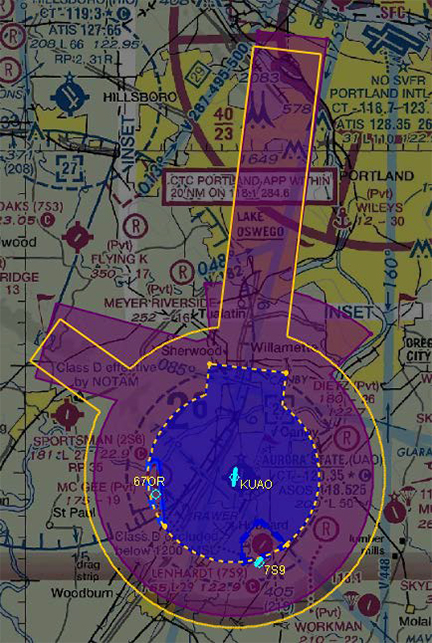FAA to revise Aurora, Oregon, airspace
The FAA has proposed to modify Class D and Class E airspace in the vicinity of Oregon’s Aurora State Airport where the establishment of Class D airspace in 2015 led AOPA to initiate a successful advocacy effort to change the way the FAA handles airspace redesigns.
Members are encouraged to review the proposal and submit formal comments by April 9.
Pilots who have flown into and out of Aurora State Airport for some time need not worry about revisiting a complicated scenario that unfolded in October 2015 when Aurora State became a Class D-airspace airport that went uncharted—with new communications frequencies in effect—until Dec. 10, 2015.
At that time, AOPA objected to reclassifying the airport's airspace before it could appear on sectional charts, noting the confusion the move could generate, as well as the risk of inadvertent airspace violations by pilots unaware of the change.

With that situation serving as an example of what to avoid in the future, the FAA subsequently took two actions as a "direct result" of AOPA’s advocacy in the matter, said Rune Duke, AOPA senior director of airspace and air traffic.
"It was very problematic that the FAA made the Class D airspace effective before it could be depicted on the sectional chart,” he said. “AOPA submitted a request that the FAA make it their policy that effective dates match up with the sectional chart publication cycle. This request was accepted by the FAA and was implemented in the October 2017 edition of the JO 7400.2, Procedures for Handling Airspace Matters.
The new airspace redesign proposal’s docket also reflects new FAA policy by including a graphic that illustrates the proposed new airspace boundaries.
"The inclusion of the graphic is the result of a separate AOPA formal request, also adopted as FAA policy with the October 2017 edition of JO 7400.2," Duke said. "We appreciate the FAA working to be more transparent and making it easier for pilots to comment on airspace rule changes.”
Pilots who wish to comment on the new proposal by the April 9 deadline may do so online or by mail to U.S. Department of Transportation, Docket Operations, 1200 New Jersey Avenue SE, West Building Ground Floor, Room W12-140, Washington, DC 20590. Please identify "FAA Docket No. FAA-2017-1034; Airspace Docket No. 17-ANM-23," at the beginning of your comments.
Please also share your comments with AOPA.




